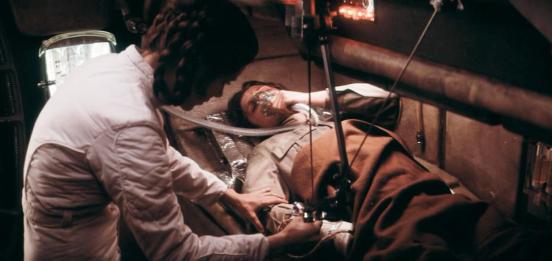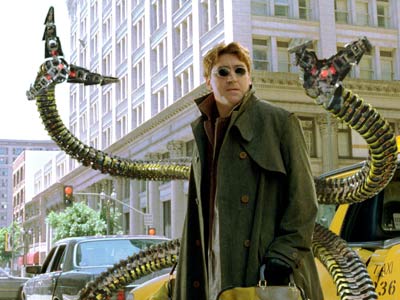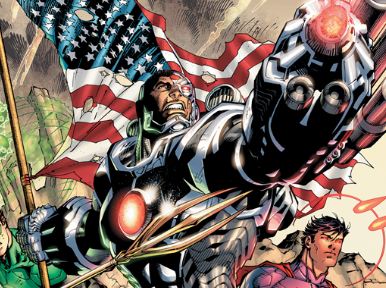![borg com label]()
![Hall of Fame label]()
By C.J. Bunce
We highlight them all the time here at borg.com. But some of them don’t naturally come to mind when you think of cybernetically enhanced organisms–cyborgs, or borgs for short. What makes a borg? An organism, human, alien, or animal, who has been modified by technology or uses technology as part of or in place of another biological function. We use this broadly, encompassing not only a long-accepted group of borgs that are more metal than man, but also robots or androids modified with biology or biomatter, although taken to the extreme this would seem to include the bioneural starship USS Voyager from Star Trek Voyager.
Regardless of how you define it, meet our borg.com Hall of Fame, always ready for new honorees…
![Iron Man]()
With Marvel’s big premiere of Joss Whedon’s The Avengers, we’ll begin with Tony Stark’s Iron Man. Tony Stark is not advertised as a borg, but if your power source involves techno-gadgetry via an arc reactor and you have his fully integrated armor, we think that makes you a borg. Whedon is very familiar with borgs, having created the character Adam, the nasty, almost unstoppable foe of the Scooby Gang in Whedon’s Buffy the Vampire Slayer.
![Borg Adam from Buffy]()
If Iron Man is a borg, should one of the oldest creatures of science fiction be considered a borg as well–Frankenstein’s monster? How integral are those bolts and attachments to his survival anyway? Does an external power source make a borg? Did he ever have to regenerate?
![Frankenstein's monster]()
And if Frankenstein’s monster makes the cut, maybe this spin-off fellow should, too:
![Frankenberry]()
Yes, Frankenberry, the only cereal mascot borg? Are those pressure gauges on his head? What functions do they serve? Before we move forward very far in time, we also think we need to at least consider Maria’s doppelganger from Fritz Lang’s sci-fi film classic Metropolis as a possible borg.com honoree–a robot admittedly, but somehow transformed into a humanoid creation with flesh, used to replace the real Maria and wreak havoc across Metropolis:
![Robot transformation to look like Maria]()
From one of the biggest science fantasy franchises, Star Wars, Darth Vader began as Anakin Skywalker, but through his own rise to evil and subsequent downfall he became more machine than man:
![Borg Darth Vader]()
He even caused his son to require borg technology by slicing off his arm and hand with his lightsaber, making Luke Skywalker a borg as well:
![luke hand repair]()
With Star Wars Episode III: Revenge of the Sith, we met an interesting new villain, General Grievous, a four-lightsaber wielding almost lobster-like biological creature made up of techno-armor and, in close-up are those reptilian eyes? His apparent disfigurement and breathing problems hint at a back story that must be not unlike Vader’s.
![Borg General Grievous]()
In The Empire Strikes Back we also briefly met Lando Calrissian’s majordomo who possessed some type of brain adapter technology–we learn from action figures, trading cards and comics his name is Lobot:
![Borg Lobot]()
And probably the very first cyborg to be referred to specifically as a “borg” (by Luke Skywalker, even), Valance was a cyborg bounty hunter in the early pages of Star Wars, the Marvel Comics series:
![Borg Star Wars Valance]()
Some borgs are more cybernetic than organism, at least at first appearance. This would include Doctor Who’s Cybermen:
![Borg Cybermen]()
and we’d learn even the Daleks were cybernetic organisms:
![Borg Daleks]()
and the Terminators from the Terminator movie and Sarah Connor Chronicles TV series, very much more machine with a bit of organics (and even Arnold’s character called himself a “cybernetic organism”):
![Borg Terminator]()
In Star Trek: First Contact the Borg Queen alters the android Lieutenant Commander Data in such a way so as to make Pinocchio a real boy:
![Borg Data and Borg Queen]()
giving real organic material to Data, (like Maria’s double above from Metropolis?) bringing him briefly into the realm of borg status, like Isaac Asimov’s Bicentennial Man:
![Borg Bicentennial Man]()
and this even suggests the Tin Man from L. Frank Baum’s The Wizard of Oz may be a rudimentary variant borg being along the lines of Frankenstein’s monster:
![Borg Tin Man]()
All humanoids or aliens modified to become The Borg of the Star Trek franchise clearly are good examples of cyborg beings, the most famous of which are probably Patrick Stewart’s Locutus:
![Borg Locutus]()
the seemingly innocent Hugh:
![Hugh borg]()
and Seven of Nine from Star Trek Voyager:
![Borg Seven of Nine]()
On Earth we encounter humans all the time with bodies improved by borg technology. Because of the OSI Steve Austin and Jaime Sommers were rescued from near death with enhanced biology and appendages to become the Bionic Man and Bionic Woman:
![Borg Bionic Woman and Bionic Man]()
The British agent James Bond had to take on Doctor No, an evil scientist who took on his own technological enhancements because of medical maladies, bringing James Bond into the fold of genre franchises investigating a borg character:
![Borg Doctor No]()
Featured in a 1980s movie series and soon to be the subject of a new movie, Robocop:
![Robocop]()
showed us a variant on Austin and Sommers, and a bit like Iron Man, we have the government creating technology to make super-humans, and here, a superhuman police officer. This is taken even further, making three animals into borgs for military use in the Eisner-nominated comic book mini-series WE3:
![Borg WE3]()
…a far darker take on the classic cartoon character Dynomutt from Scooby Doo:
![Borg Dynomutt]()
Inspector Gadget:
![Borg Inspector Gadget]()
and Doctor Octopus (Doc Ock) in Spider-man 2:
![Borg Doc Ock]()
both were borgs that made it into big-screen films.
In the DC Comics universe we have a newer Justice League featured member Cyborg, a football player/student who is in the wrong place at the wrong time, when his father’s lab goes up in flames and his father uses his own research to save his son from death:
![Borg Cyborg from DC]()
Before that, Frank Miller envisioned a disfigured future world Green Arrow who would need his own prosthetic cybernetic arm in The Dark Knight Returns:
![Borg Green Arrow]()
Mr. Freeze was an early borg villain in the Batman series:
![Borg Mr Freeze]()
In Marvel Comics Rich Buckler created Deathlok the Demolisher, another cyborg creation, and one of the earliest borgs in comics:
![Borg Deathlok]()
Add to that Marvel characters like Ultron, the “living” automaton:
![Borg Ultron]()
Ultron’s own creation, named Vision, the “synthezoid”–
![Borg Marvel Vision]()
and the borg called Cable:
![Borg Cable]()
In the 1990s Jim Lee created the Russian borg in the pages of X-Men called Omega Red:
![Borg Omega Red]()
Long before these Marvel characters the cyborgs Robotman and Robotdog graced the pages of DC Comics in the 1940s, and yes, they were not just robots:
![Robotman and Robot Dog]()
The modern Cylons from the reboot Battlestar Galactica TV series are borgs in the Terminator sense, robots made to look and pass for human. And there were a bunch, not just background, but named characters, the most famous of which was the seductive Number Six:
![Battlestar Galatica]()
![Borg Even More Cylons]()
![Borg Cylons]()
![Borg Six the Cylon]()
Years before, Philip K. Dick would create more than one borg character in his novels and short stories, revealed to us the best as the Replicants in Ridley Scott’s Blade Runner:
![Borg Replicant]()
Several replicants appeared in the film:
![Blade Runner replicants]()
![replicant]()
![Fourth replicant]()
…all indistinguishable from humans to the naked eye.
In the horror realm we have Ash, from Evil Dead and Army of Darkness, his arm a functioning chainsaw, and at least in the comic book, like the Star Trek borgs he has an interchangeable arm like a mega Swiss Army knife:
![Ash]()
If we include Ash do we also need to include Cherry Darling from Planet Terror, since she has a rifle as a leg like Ash’s arm attachment?
![Cherry Darling]()
Heck, even horrific camp troller Jason became a borg eventually in Jason X:
![Borg Jason X]()
Todd MacFarlane’s Spawn comics had both the borg assassin Overtkill:
![Borg Overtkill]()
and the cybernetic gorilla Cy-Gor:
![Borg Cy-Gor]()
Speaking of borg beasties, even Japanese monster movies embraced borgs, having their hero Godzilla encounter Mechagodzilla:
![Borg Mechagodzilla]()
and Gigan:
![Borg Gigan]()
In the world of manga and anime we have Ghost in the Machine’s own borg girl Motoko Kusanagi:
![Borg Motoko]()
leader of a group of borgs, and the villain Cell from Dragon Ball:
![Borg Cell]()
Cowboy Bebop had the borg character Jet Black, which seems influenced by the design of Seven of Nine:
![Borg Jet Black]()
Akira had Tetsuo Shima:
![Borg Tetsuo Shima]()
And we have a new one to add to the list because of the film Prometheus, the creepy borg, David 8:
![Borg David 8]()
But he’s certainly not the first in Ridley Scott’s Alien universe. Don’t forget Ian Holm’s Ash in Alien:
![Borg Holm Ash]()
Lance Henrikson’s Bishop from Aliens:
![Borg Bishop Aliens]()
and Winona Ryder’s Annalee Call from Alien: Resurrection:
![Annalee Call]()
But these are just the biggest examples of borgs in popular genre works. Countless books, comics and short stories have introduced other borg beings, not to mention every other new video game. What will be the next borg to enter the mainstream, with a new TV show or movie?
Should we add an Honorable Mention list to the borg.com Borg Hall of Fame, for beings resulting from the merging of humans with cyberspace? Think of characters like Tron and Flynn from Tron and Tron: Legacy? Or Neo and Trinity & Co. from the Matrix movies? You can argue some of the above in or out of the list, but we’ll be visiting most of them here now and then.
We’ll update this list from time to time and feature it as its own page on the borg.com home page.
![]()
![]()







































































































 ” story arc featuring the first appearance of Patrick Stewart as Locutus. The April 25 screening at 7 p.m. local time will also include a “making of” feature as part of the screening.
” story arc featuring the first appearance of Patrick Stewart as Locutus. The April 25 screening at 7 p.m. local time will also include a “making of” feature as part of the screening.
 at
at  and
and  at
at 





 ,” courtesy of IDW Publishing. Find the trade edition at your local comic book store tomorrow, or you can find it online, including
,” courtesy of IDW Publishing. Find the trade edition at your local comic book store tomorrow, or you can find it online, including 




















